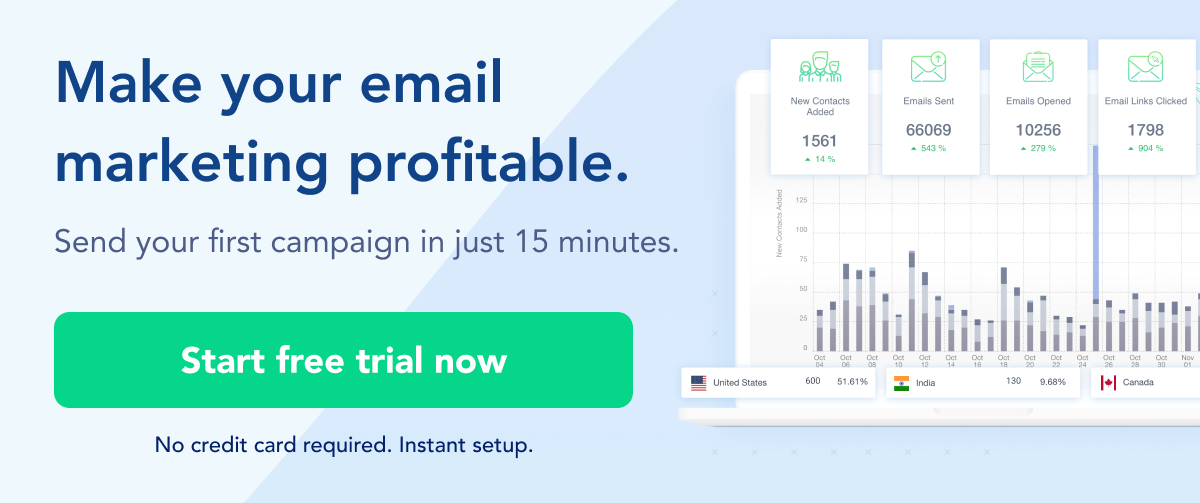Have you ever wondered why some of your emails never reach your subscribers' inboxes?
Hint: Your domain reputation could be the reason.
Domain reputation is a measure of how trustworthy your domain is in the eyes of email service providers (ESPs) and internet service providers (ISPs).
A positive domain reputation is crucial for delivering emails and avoiding spam filters.
Many factors, ranging from authentication to engagement, affect reputation. That’s why maintaining a healthy domain reputation requires comprehensive monitoring and improvement strategies.
This article will explore how to improve domain reputation in 5 key ways. By implementing these tactics, you'll be on the path to enhancing your online presence and establishing trust with your audience.
Let’s begin.
How to Improve Domain Reputation in 5 Ways
Maintaining a positive domain reputation is paramount for businesses and individuals alike. It can help establish trust, reliability, and credibility in the eyes of potential customers, partners, and employees.
It can also increase customer engagement and generate greater market share and value for companies. Here’s how you can improve domain reputation and boost your email deliverability.
1. Authenticate Your Emails
Properly authenticating your emails is a crucial step in building a positive domain reputation. Email authentication works as a stamp of authority to show email providers that messages are sent from your domain, rather than spoofed by spammers.
Authentication protocols help you establish your domain's identity and credibility with email receivers. They also help protect your domain from email spoofing and phishing, which can harm your reputation and deliverability.
The main email authentication methods are:
- SPF (Sender Policy Framework): Verifies the server or IP address sending emails on your domain's behalf. It helps receivers check if the email's sender matches the domain in the "From" header. If not, the email may be rejected or marked as spam.
- DKIM (DomainKeys Identified Mail): Uses cryptographic or digital signatures to verify that email content hasn’t been tampered with. It helps receivers confirm the email originates from your domain and that it hasn’t been altered by a third party.
- DMARC (Domain-based message Authentication, Reporting, and Conformance): Aligns SPF and DKIM to reject unauthenticated messages. It allows you to set policies for how receivers should handle unauthenticated emails from your domain.
Source: AVASOFT
Together, these protocols authenticate your mail server and validate that emails originate from your domain.
Verifying your legitimate right to send email from your domain has a major influence on inbox placement. Without proper authentication, your domain's reputation could take a serious hit.
If ISPs label your domain as untrustworthy, legitimate emails you send could end up going to spam folders or get blocked altogether. It could hamper your email campaigns and reduce your ROI.
Consistently authenticating all your emails helps build delivery trust with ISPs and protects your sender reputation. If using an ESP, go for one like SendX. It provides email authentication for free with every plan, and encourages users to get their domains authenticated with it.
This can improve your email deliverability, open rates, and conversions. It can also reduce the risk of your emails being flagged as spam or phishing by mistake.
2. Maintain a Clean Email List
A high-quality subscriber list is essential for building domain reputation.
Emails sent to inactive or invalid addresses lead to bounces, which signal poor list hygiene. High bounce rates are a red flag for email service providers and can tarnish your domain's credibility.
Spam complaints can also severely damage your reputation. These are often the result of sending emails to uninterested parties or those who didn’t consent to receive communication. And here’s the thing: spam complaints increase if subscribers don’t recognize your emails.
So, here are some tips to help you maintain a clean email list:
- Conduct email list maintenance at least quarterly: Ensure you search for obvious issues like inactive domains or spam trap addresses. Also, review subscriber engagement to remove those who never open your emails. You could even measure subscriber growth over time to track audience response to your content. This can help you tailor email marketing efforts for higher engagement.
- Scrub for hard and soft email bounces: Hard bounces signal invalid emails that should be removed. Soft bounces may indicate temporary issues, but remove all those that bounce consistently. Make sure you scrub for bounces after each campaign.
- Use double opt-ins: These require subscribers to confirm their email address after signing up. They ensure that only those who are genuinely interested in hearing from you make it onto your list. Double opt-ins also verify that subscribers have provided a valid email address. Make sure you mention double opt-ins in your form through the form builder so subscribers know they have to verify their email.
Source: SendX
- Limit spam complaints: The best way to do this is to send subscribers relevant content that they want. Next, monitor complaints and make unsubscribing easy in every email. Too many complaints can lead to your domain being flagged as suspicious, which will negatively impact your domain reputation.
3. Send Relevant and Engaging Content
The value your emails provide subscribers directly influences your domain reputation.
When you craft relevant, engaging emails, it leads to higher open rates and engagement. This demonstrates you’re an authoritative sender who people want to hear from. Inbox providers recognize when users engage with and look forward to your content. It’s a positive signal that boosts your domain reputation.
Here are some tips to help you send relevant and engaging content:
- Understand your audience: To create relevant and engaging content, you need to understand your audience's needs, preferences, and pain points. You can use surveys, polls, feedback forms, or analytics tools to gather insights about your subscribers. Based on these insights, you can tailor your email content to match their interests, goals, and challenges.
- Create educational content: One way to create engaging content is by delivering educational content that builds trust and authority. You could share guides or courses created on online course platforms through email. Alternatively, your email newsletters could contain something that educates the receivers. This will help you establish yourself as an expert in your field and build a loyal following.
- Personalize your content: To ensure your content is relevant, segment your email list based on subscriber interests and preferences. Use data on subscriber interests and past engagements to personalize your emails. For example, you can use it to recommend products or services that are relevant to their interests.
- Test and optimize your emails: A/B test several email variations and continually optimize based on open and click-through rates. Write crisp copy and see which subject lines compel receivers to open your emails. Format your emails for easy mobile reading, and consistently evaluate subscriber feedback to improve content.
Image via SendX
Sending relevant and engaging content is not only good for your domain reputation, but also for brand reputation. It helps you establish a loyal and satisfied customer base that will spread positive word-of-mouth about your business.
4. Monitor Email Engagement Metrics
One of the best ways to monitor and improve your domain reputation is to regularly track your email engagement metrics. These metrics provide invaluable insights, including how recipients interact with your emails.
Metrics like open rates, click-through rates, and conversion rates reveal the relevance, value, and trustworthiness of your emails. You can compare your rates with industry averages below to see if you’re doing well or need to up your game.
High engagement metrics signify your content resonates with subscribers. This can significantly boost your domain reputation and email deliverability.
On the other hand, low engagement metrics often signal issues with your messaging or content. If your emails fail to meet subscriber needs or expectations, they are less likely to be clicked on or opened. Low engagement harms your domain reputation, increasing the chances of being marked as spam.
While maintaining high engagement is ideal, it's also important to watch for sudden drops. Rapidly falling open or click-through rates can signal deliverability issues. This requires prompt intervention to diagnose and address the underlying causes.
Trends like declining open rates over several campaigns can point to growing relevance issues. Your subject lines may have gone stale or your content formats become too predictable. Refreshing these elements can re-engage subscribers.
5. Respond to Spam Complaints Promptly
How you handle spam complaints and unsubscribe requests plays a key role in managing your domain reputation.
Spam complaints are signals that some of your recipients aren’t happy with your emails and want to stop receiving them. If you ignore these complaints, you risk damaging your domain reputation and getting your emails blocked or filtered by ESPs.
So, how should you deal with spam complaints?
- Make unsubscribing straightforward: An easy and transparent way to do this is to include a clear link in every email. Never obscure or complicate the process. Instead, immediately honor opt-out requests and add unsubscribers to your suppression list.
- Diagnose the source of complaints: Was a technical issue responsible for landing your emails in spam? Could a recent marketing message have upset subscribers? You may need to adjust your email frequency, content, or targeting to ensure you’re sending relevant and valuable emails to your audience.
- Closely monitor spam complaints and your feedback loop: Complaints from a few subscribers likely signal a deliverability issue or flawed segmentation. Widespread complaints, on the other hand, warn of more serious reputational damage that requires intervention.
- Reply to complaints helpfully: Apologize for the frustration and explain how you’ll work on improving the experience going forward. Consider allowing affected subscribers to opt into receiving only your most valuable content.
To rebuild credibility, proactively showcase positive feedback from satisfied customers. You could embed Google reviews prominently on your website or emails to demonstrate that people find your brand and content helpful rather than unwanted.
Prompt complaint resolution combined with visible, trust-building social proof indicates an active commitment to sending only relevant, desired emails. This helps remedy reputation issues before they escalate and lead to potential blacklisting of your domain.
Enhance Your Domain Reputation for Email Success
Maintaining a positive domain reputation requires constant monitoring across key areas like authentication, list management, engagement, and feedback.
By embracing these strategies, you’ll boost your credibility and ensure your emails resonate with your audience.
Build a stellar reputation through relevance and trust, and your domain will be seen as a respected sender who provides value.
Ultimately, these best practices only demonstrate how to improve domain reputation. You must implement them well to ensure your emails consistently reach their intended recipients.



